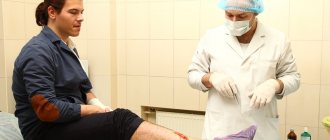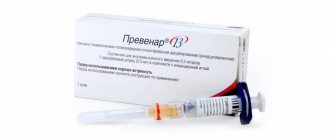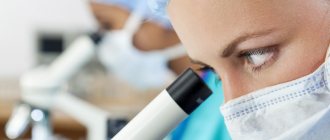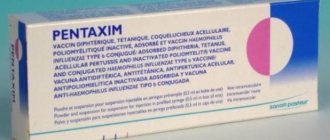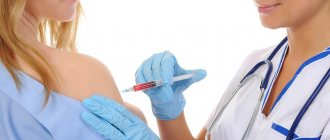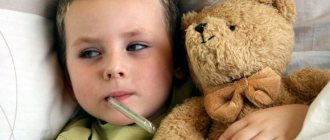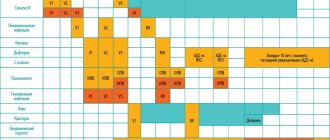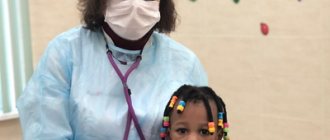Prices
Our doctors
How to get there
Make an appointment
Please check the cost of services with the clinic’s medical consultants by phone
| Service | Price |
| KOKAV Rabies vaccine culture concentrated purified inactivated | 1100 rub. |
Externally, the vaccine is a hygroscopic porous white mass. After dissolution, it becomes white. Kokav provides the formation of immunity and effective protection against rabies. Vaccination is carried out for preventive or therapeutic purposes.
The Kokav vaccine is a rabies virus grown on a primary culture of Syrian hamster kidney cells and has undergone special purification.
Features of the use of the Kokav vaccine
The main indication for rabies vaccination for therapeutic and prophylactic purposes is the bite of an unknown animal or an animal with signs of rabies. In this case, there are no contraindications to immunization.
Before administering the vaccine, the bite wound must be treated. The wound surface is treated with a soap solution, and the edges of the wound are treated with alcohol or tincture of iodine. If the wounds are extensive, suturing is performed.
For therapeutic and prophylactic purposes, vaccination should be carried out as soon as possible after the bite has occurred. The dose is calculated depending on the patient's body weight. The vaccination schedule is detailed in the instructions for the drug.
The standard vaccination schedule is as follows:
1 vaccine - 3 day – 7 day – 14 day – 30 day – 90 day. The severity of the bite is taken into account.
Administration of the vaccine for therapeutic purposes is stopped after the third dose if the animal does not show signs of disease. If it is not possible to observe the animal (in the case when it has disappeared), treatment must be continued. Doses and immunization schedules are the same for adults and children.
During the period of taking the vaccine for therapeutic and prophylactic purposes, it is not recommended to drink alcoholic beverages. It should also be taken into account that some medications (immunosuppressants and corticosteroids) reduce the effectiveness of the drug.
Kokav vaccination can also be carried out for purely preventive purposes. The introduction of vaccination in this case is indicated for a specific group of people. These are veterinarians, hunters, people working to catch stray animals, foresters, and taxidermists.
Primary immunization in this case involves the administration of three vaccines. In the future, the first revaccination is carried out after a year, and subsequent vaccinations every three years.
KOKAV anti-rabies vaccine culture concentrated purified inactivated
The contents of the vaccine ampoule must be dissolved in 1.0 ml of water for injection. Dissolution time should not exceed 5 minutes. The dissolved vaccine is a clear or slightly opalescent liquid from colorless to light yellow.
Storage of the dissolved vaccine for more than 5 minutes is not allowed.
The dissolved vaccine is injected slowly intramuscularly into the deltoid muscle of the shoulder, for children under 5 years old - into the upper part of the anterolateral surface of the thigh.
Injection of the vaccine into the gluteal region is not allowed.
Providing anti-rabies assistance
Anti-rabies care consists of local treatment of wounds, scratches, abrasions, salivation sites and the subsequent administration of a vaccine to prevent Kokav rabies or, if indicated, a combined administration of rabies immunoglobulin (RAI) and a vaccine to prevent Kokav rabies. The interval between the administration of AIH and Kokav is no more than 30 minutes.
Local treatment of wounds Local treatment of wounds (bites, scratches, abrasions) and salivation sites should begin immediately or as soon as possible after a bite or injury. It consists of generously washing the wound surface for several minutes (up to 15 minutes) with water and soap or another detergent (detergent) or, in the absence of soap or detergent, the damaged area is washed with a stream of water. After this, the edges of the wound should be treated with 70% ethyl alcohol or 5% alcohol solution of iodine.
Sutures should be avoided whenever possible. Suturing is indicated only in the following cases:
- for extensive wounds - several guiding skin sutures after pre-treatment of the wound;
- for cosmetic reasons (skin sutures on facial wounds);
- suturing of bleeding vessels in order to stop external bleeding.
If there are indications for the use of rabies immunoglobulin, it is used immediately before suturing (see section Dose of rabies immunoglobulin (RAI)).
After local treatment of wounds (damages), therapeutic and prophylactic immunization is immediately started.
Therapeutic and preventive immunization
A detailed scheme of therapeutic and prophylactic immunization and notes to the scheme are presented below in the “Scheme of therapeutic and prophylactic vaccinations with the vaccine for the prevention of rabies Kokav and rabies immunoglobulin (RAI)”.
All persons at risk of contracting rabies are subject to therapeutic and prophylactic immunization. If there are indications for combined treatment, then AIG is first administered and, no more than 30 minutes later, Kokav is administered after it.
Rabies immunoglobulin (RAI) is prescribed as soon as possible after contact with a rabid or suspected rabid animal, wild or unknown animal.
Before administering heterologous (horse) rabies immunoglobulin, it is necessary to check the individual sensitivity of the patient to horse proteins (see ((Instructions for the use of rabies immunoglobulin from liquid horse blood serum). Heterologous anti-rabies immunoglobulin is administered no later than 3 days after the bite.
Before administering homologous (human) rabies immunoglobulin, individual sensitivity is not tested. Homologous anti-rabies immunoglobulin is administered no later than 7 days after the bite.
Dose of rabies immunoglobulin (RAI). Heterologous (horse) rabies immunoglobulin is prescribed at a dose of 40 IU per 1 kg of body weight. The volume of administered heterologous rabies immunoglobulin should not exceed 20 ml. Homologous (human) rabies immunoglobulin is prescribed at a dose of 20 IU per 1 kg of body weight.
Introduction of AIG. As much of the recommended dose of AIH as possible should be infiltrated into the tissue around the wound and deep into the wound. The unused part of the dose of the drug is injected deep intramuscularly at a site other than the injection site of the aitirabic vaccine.
Scheme of therapeutic and prophylactic vaccinations with the vaccine for the prevention of rabies Kokav and rabies immunoglobulin (RAI).
| Damage category | Nature of contact | Animal details | Treatment |
| 1 | There is no damage to the skin, no drooling of the skin, no drooling of the mucous membranes. | Rabies patient | Not assigned |
| 2 | Salivation of intact skin, abrasions, scratches, superficial bites of the torso, upper and lower extremities (except the head, face, neck, hand, fingers and toes) caused by domestic and farm animals. | If within 10 days of observation of the animal it remains healthy, then treatment is stopped (i.e. after the third injection). If the absence of rabies in an animal is laboratory proven, then treatment is stopped from the moment the absence of rabies is established. In all other cases, when it is impossible to monitor the animal for 10 days (killed, died, ran away, etc.), continue treatment according to the indicated scheme. | Prescribe treatment immediately: Kokav 1.0 ml on days 0, 3, 7, 14, 30, 90 |
| 3 | Any drooling of the mucous membranes, any bites of the head, face, neck, hand, fingers and toes, genitals; single or multiple deep lacerations caused by domestic or farm animals. Any salivation and damage caused by wild carnivores, bats and rodents. | If it is possible to monitor the animal and it remains healthy for 10 days, then treatment is stopped (i.e. after the third injection). If the absence of rabies in an animal is laboratory proven, then treatment is stopped from the moment the absence of rabies is established. In all other cases, when it is impossible to monitor the animal, continue treatment according to the specified regimen. | Start immediately combined treatment with rabies immunoglobulin: AIH on day 0 (see Dose of rabies immunoglobulin (AITO and vaccine for the prevention of rabies: Kokav 1.0 ml on days 0, 3, 7, 14, 30 and 90 |
Notes to the Scheme of therapeutic and prophylactic vaccinations with the vaccine for the prevention of rabies Kokav and rabies immunoglobulin (RAIG):
1. Doses and regimens of therapeutic and prophylactic immunization are the same for children and adults.
2. A course of therapeutic and prophylactic immunization is prescribed regardless of the timing of the victim’s request for rabies treatment, even several months after contact with an animal with rabies, an animal suspected of having rabies, a wild or unknown animal.
3. For persons who have previously received a full course of therapeutic and prophylactic or preventive vaccinations, from the end of which no more than 1 year has passed, three injections of the vaccine for the prevention of rabies Kokav 1.0 ml are prescribed on days 0.3, 7; if a year or more has passed or an incomplete course of immunization has been carried out, then vaccinations are carried out in accordance with the given “Scheme of therapeutic and prophylactic vaccinations with the vaccine for the prevention of rabies Kokav and rabies immunoglobulin (RAI).”
4. After a course of therapeutic and prophylactic or preventive immunization, the vaccinated person is issued a certificate (certificate of preventive vaccinations) indicating the type and series of drugs, the course of vaccinations and the presence of post-vaccination reactions.
5. The vaccinated person must know: he is prohibited from consuming any alcoholic beverages during the entire course of vaccinations and 6 months after its completion. You should also avoid overwork, hypothermia, and overheating during the entire course of vaccinations.
6. Glucocorticosteroids and immunosuppressants can lead to ineffectiveness of vaccine therapy. Therefore, in cases of vaccination while taking corticosteroids and immunosuppressants, determination of the titer of virus-neutralizing antibodies is mandatory. In the absence of virus-neutralizing antibodies, an additional course of vaccine administration is carried out according to the scheme of 0, 7 and 30 days.
Preventive immunization
The vaccine is administered intramuscularly into the deltoid muscle of the shoulder, 1.0 ml on days 0, 7 and 30. Revaccination is carried out once, in a dose of 1.0 ml every year and then every three years.
Preventive immunization scheme
| Primary immunization | Three injections on days 0, 7 and 30, 1.0 ml each |
| First revaccination after 1 year | One injection, 1.0 ml |
| Subsequent revaccinations every 3 years | One injection, 1.0 ml |
Preventive immunization of populations at increased risk of rabies infection is carried out in vaccination rooms of medical institutions, where they fill out and issue a “Certificate of Preventive Vaccinations”, where all the necessary information is entered (names, series, doses, multiplicities and dates of receipt of drugs).
Precautions for use.
The drug is not suitable for use in ampoules with damaged integrity, labeling, as well as changes in color and transparency, expired expiration date, or improper storage. The opening of the ampoules and the vaccination procedure are carried out under strict adherence to the rules of asepsis. The vaccinated person must be under medical supervision for at least 30 minutes. Vaccination sites must be equipped with anti-shock therapy.
Contraindications, precautions and side effects
If the Kokav vaccine is taken after an animal bite for therapeutic and prophylactic purposes, no contraindications are noted, due to the great danger of rabies for human health and life.
When it comes to preventive vaccination, the following contraindications are identified:
- the patient has signs of acute infectious diseases - in this case, vaccination is carried out a month after recovery;
- development of allergic reactions after previous vaccines;
- allergy to antibiotics;
- period of bearing a child.
After vaccination, the patient must be under medical supervision for 30 minutes.
The Kokav vaccine is not combined with other drugs. After completing the patient's treatment for rabies, vaccinations against other infectious diseases are allowed only after two months.
Possible side effects:
- slight swelling, redness and thickening of the skin at the injection site;
- headache, general malaise;
- allergic reactions such as rash or angioedema;
- increased body temperature, fever;
- serum sickness.
Serum sickness usually occurs 6-8 days after administration of immunoglobulin. Anaphylactic reactions require medical attention and placement of the patient in a specialized medical facility. He is prescribed antihistamines.
No cases of vaccine overdose have been recorded. Considering the fact that rabies has a 100% fatality rate, in no case should a violation of the vaccine administration schedule be allowed.
At the end of the course of taking the drug for therapeutic and prophylactic purposes, the patient is given a certificate of vaccination.
COVID-19: vaccines and contraindications
Many people have chronic diseases, allergies and other pathologies in modern life. And some of them are a “medical diversion” from the “anti-Covid” vaccination. The truth is, which ones exactly are almost never specified in the popular media. While a contraindication becomes a reason for increased alertness to infection, an obstacle to receiving a QR code and a reason for many restrictions.
Absolute
In one of our articles, we have already mentioned the structural features of anti-Covid vaccines (article “Comparison of Vaccines”), which are the cause of different reactogenicity.
Despite the different mechanism of action, general contraindications to vaccination remain the same for all existing drugs. And a “permanent” (not temporary) medical exemption from vaccination is issued in the following cases:
- critical allergic reactions to previous vaccinations (Quincke's edema, anaphylactic shock, polymorphic exudative eczema and others),
- hypersensitivity to vaccine components (for example, aluminum hydroxide, which is part of EpiVacCorona),
- pregnancy,
- breastfeeding
- under 18 years of age (at the time of writing due to the lack of data on the effectiveness and safety of vaccines in this group of patients),
- acute vascular reactions to any vaccine at the time of vaccination (collapse, shock-like states), recorded in the patient’s medical record
A medical withdrawal from the second “dose” is indicated if after the administration of the first there were: fever over 40C, convulsions, anaphylactic shock, collapse, swelling at the injection site with a diameter of more than 8 cm (in particular for CoviVac) and other recorded severe reactions after the first vaccination .
Temporary
Temporary contraindications include:
- acute period of any infectious diseases (including ARVI)
- non-infectious (severe injuries, burns, surgeries and other) inflammatory processes,
- period of exacerbation of chronic diseases,
vaccination for which should be delayed for at least 2-4 weeks (at least 4 weeks for EpiVacCorona) after recovery or achievement of complete remission.
And in case of mild ARVI, as well as acute intestinal infections, vaccination can be done within a few days after the temperature has returned to normal.
Relative
Vaccination can be done with caution in those who have:
- chronic liver and kidney diseases,
- severe disorders of the pituitary gland and hypothalamus,
- severe pathologies of the hematopoietic system (significant deviations in the level and functioning of red blood cells, leukocytes, platelets),
- diseases of the central nervous system (epilepsy, recent stroke),
- cardiovascular (coronary heart disease, endocarditis, pericarditis, myocarditis),
- bronchopulmonary (chronic obstructive pulmonary disease, bronchial asthma, fibrosing alveolitis and others),
- digestive (malabsorption syndrome, Crohn's disease and others)
- and endocrine systems (decompensation of diabetes mellitus, severe disorders of the thyroid gland, etc.),
- as well as immune disorders (allergic and autoimmune diseases).
And the final decision in favor of vaccination or medical treatment remains at the discretion of the attending physician, who balances the risk of potential infection with the risk of possible complications from vaccination.
For people with autoimmune pathologies and malignant neoplasms, the use of vaccines may be associated with special risks due to stimulation of the immune system and an unpredictable reaction to the latter. However, due to the lack of data on the percentage probability and nature of post-vaccination complications in such patients, the decision to vaccinate still remains at the discretion of the attending physician.
Those who have IgG antibodies to the coronavirus S1 protein after an infection may not be vaccinated. For at least 6 months from the date of the “documented” infection.
Well, if antibodies have been developed asymptomatically, the question of the need for vaccination is decided individually, depending on the nature of the patient’s work.
special instructions
There are not many of these vaccines available today, namely:
- In patients receiving immunosuppressive therapy or suffering from immunodeficiency conditions, the immune response to vaccination may not be sufficient. Therefore, if possible, it is recommended to discontinue the use of immunosuppressive drugs for 1 month before and after the planned vaccination;
- and the vaccine of “choice” may be CoviVac, since the use of killed whole-virion vaccines is not contraindicated in this case.
In addition, the use of most vaccines still has strict age limits - from 18 to 60 years. And only in relation to Sputnik V such restrictions are not provided, and the vaccine is recommended, including for patients over 60 years of age.
It is noteworthy that so far not a single vaccine instruction contains direct contraindications for people with coagulation disorders.
In the meantime, those who have a family history or risk factors for thrombosis are advised to check their blood for “clotting” and assess their genetic predisposition to thrombosis before getting vaccinated.
Of course, the information about vaccines is not yet complete and will be supplemented as observations accumulate.
Consequences of drinking alcohol before and after rabies vaccination
Vaccination against the terrible virus is anti-rabies. The injection will be effective only if administered in a timely manner. The correct dosage will help avoid death. If a person is bitten by an animal while intoxicated, then you should not hesitate to visit a doctor. Every moment the chance of serious complications increases.
After admitting a person who has been bitten by an animal and is intoxicated, doctors will put on a drip. This procedure will allow you to quickly remove the poison from the body. After this they get vaccinated . There is always a chance that the vaccine will not work or will not work 100%. Alcohol increases these risks. The process of alcohol allelopathy and vaccination occurs according to different scenarios:
- if a person drinks alcohol after being vaccinated against rabies, then alcohol can have a destructive effect on the vaccine;
- alcoholic drinks weaken the immune system, especially if a person has been infected by a sick animal;
- intoxicating drinks can worsen the disease (in this case, the vaccine will not have any therapeutic effect).
The vaccine developed to treat rabies consists of weakened pathogens of the virus. After its administration, the immune system begins to fight, coping with infection. When it is weakened by alcoholic drinks, the risk of complications is very high. Instead of producing substances that can cope with the disease, the body fights and eliminates toxins from alcohol-containing products.
Administering a vaccine after an animal bite and abstaining from alcohol
After being bitten by an animal, you should immediately consult a doctor. Therapy against such a terrible disease as rabies should be prescribed no later than two weeks after infection. After this time, effective treatment is difficult to achieve. bite site should be treated using a soap solution, and then go to the hospital. Even if a person drank before contacting a sick animal, there is no need to hesitate!
The attending physician will administer a vaccination that will help fight rabies before the virus penetrates the human nervous system. With the help of a course of injections given in the shoulder or thigh, the patient will acquire immunity to the disease for a period of 1 year. If a person’s immune system is weakened by alcohol-containing drinks, then there is a possibility of developing the disease.
Now it has become clear what to answer to a person who asks a question about why alcohol is not allowed after a rabies vaccination. Strong drinks cause enormous harm to the human body, and abuse of alcohol-containing drinks can lead to disastrous consequences.
If an animal has bitten you and there is a suspicion that it has rabies, then you should not only complete the full course of therapy, but also abstain from alcohol. In standard situations, treatment takes 9 months. During this period, the consumption of alcoholic beverages is strictly prohibited!
